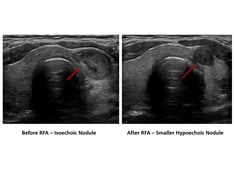Reference Range
Parathyroid hormone (PTH) is produced by the 4 parathyroid glands, which reside behind the thyroid gland in the anterior neck. The release of PTH is normally stimulated by low calcium levels in the body. PTH release results in a signal to the bones to release calcium into the bloodstream and also to the kidneys to resorb calcium in the collecting system and excrete phosphorus.
In addition, PTH plays an active role in the intestines, resulting in the conversion of vitamin D into its active form (PTH increases the activation of 25-hydroxy vitamin D to 1,25-dihydroxy vitamin D in the kidneys), which then stimulates the intestines to absorb both calcium and phosphorus. [1]
The reference ranges for PTH are as follows [2] :
-
Intact (whole): 10-65 pg/mL or 10-65 ng/L (SI units)
-
N terminal: 8-24 pg/mL
-
C terminal: 50-330 pg/mL
Interpretation
Parathyroid hormone (PTH) levels in the blood may be analyzed to determine the presence of hyperparathyroidism and its possible role in abnormal calcium levels. Parathyroid hormone influences the levels of both calcium and phosphorus in the body. A portion of PTH is split into 3 fragments in the parathyroid gland before systemic release. The 3 fragments are an amino or N-terminal fragment, a midregion fragment, and a carboxy or C-terminal fragment. The active intact PTH and the amino terminal fragment are physiologically active in the body. In some centers, assays are available to detect both active elements.
Collection and Panels
Collection
See the list below:
-
Specimen: Blood
-
Container: Lavender (EDTA) or pink (K2 EDTA). Also acceptable is a green (sodium or lithium heparin) or serum separator tube.
-
Collection method: Routine venipuncture
Panels
PTH is not typically a part of a panel and should be ordered specifically.
Background
Description
Parathyroid hormone (PTH) is produced by the 4 parathyroid glands, which reside behind the thyroid gland in the anterior neck. The release of PTH is normally stimulated by low calcium levels in the body. PTH release results in a signal to the bones to release calcium into the bloodstream and also to the kidneys to resorb calcium in the collecting system and excrete phosphorus.
In addition, PTH plays an active role in the intestines, resulting in the conversion of vitamin D into its active form (PTH increases the activation of 25-hydroxy vitamin D to 1,25-dihydroxy vitamin D in the kidneys), which then stimulates the intestines to absorb both calcium and phosphorus. [1]
Conversely, if the blood calcium level is elevated, PTH production is decreased and the previous process does not occur. This allows for excretion of excess calcium from the body. In the instance of renal disease or parathyroid disease, this normal mechanism runs awry and the result can be injurious to multiple body systems, including the bones, muscles, kidneys, and brain function.
Indications/Applications
PTH levels are helpful in identifying the underlying cause of calcium aberrations. This may delineate hyperparathyroidism, parathyroid tumors, vitamin D deficiency, renal disease, and some tumors that produce the hormone. Intraoperative PTH assays may be performed during parathyroid tumor surgery to help determine if the PTH-producing adenoma was correctly removed. [3]
A drop of more than 50% of the preoperative level 10 minutes after gland removal can be confirmation that the correct gland with the PTH-producing adenoma was removed. If the level does not drop by 50% and ends up in the normal range, another source should be sought. [4] Some authors suggest waiting 20 minutes to avoid unneeded bilateral neck exploration and associated risk of complications with only a slight increase of the duration of surgery and of the costs due to variations in individual PTH half-life and alterations in the patient's physiological state during surgery. [5]
Considerations
Often, in conditions in which abnormal calcium levels are detected, PTH may be drawn and interpreted along with serum calcium, phosphorus, magnesium, vitamin D, and urine calcium levels. The understanding of PTH in relation to the other listed labs may allow for an appropriate diagnosis of the underlying pathology.
Some authors recommend that samples for PTH measurement should be placed into tubes containing EDTA, during the times of 10:00am and 4:00pm, and plasma separated within 24 hours of venipuncture. These recommendations are related to multiple differences noted in methods of collections: central venous PTH concentrations versus peripheral venous concentrations, storage collection temperature and time until analysis, and variations in levels related to a circadian rhythm (ie, a nocturnal acrophase and midmorning nadir. [6]







